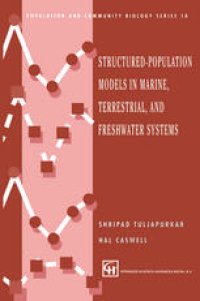
Ebook: Structured-Population Models in Marine, Terrestrial, and Freshwater Systems
- Tags: Ecology, Evolutionary Biology, Mathematical and Computational Biology
- Series: Population and Community Biology Series 18
- Year: 1997
- Publisher: Springer US
- Edition: 1
- Language: English
- pdf
In the summer of 1993, twenty-six graduate and postdoctoral stu dents and fourteen lecturers converged on Cornell University for a summer school devoted to structured-population models. This school was one of a series to address concepts cutting across the traditional boundaries separating terrestrial, marine, and freshwa ter ecology. Earlier schools resulted in the books Patch Dynamics (S. A. Levin, T. M. Powell & J. H. Steele, eds., Springer-Verlag, Berlin, 1993) and Ecological Time Series (T. M. Powell & J. H. Steele, eds., Chapman and Hall, New York, 1995); a book on food webs is in preparation. Models of population structure (differences among individuals due to age, size, developmental stage, spatial location, or genotype) have an important place in studies of all three kinds of ecosystem. In choosing the participants and lecturers for the school, we se lected for diversity-biologists who knew some mathematics and mathematicians who knew some biology, field biologists sobered by encounters with messy data and theoreticians intoxicated by the elegance of the underlying mathematics, people concerned with long-term evolutionary problems and people concerned with the acute crises of conservation biology. For four weeks, these perspec tives swirled in discussions that started in the lecture hall and carried on into the sweltering Ithaca night. Diversity mayor may not increase stability, but it surely makes things interesting.
This indispensable guide provides a comprehensive treatment of the construction and analysis of models for age- and stage-classified populations. It covers methods based on projection matrices, delay-differential equations, and partial-differential equations. The book addresses both field and laboratory studies on a wide range of specific ecosystems and taxa, as well as problems in evolution, genetics, conservation biology and epidemiology.
This indispensable guide provides a comprehensive treatment of the construction and analysis of models for age- and stage-classified populations. It covers methods based on projection matrices, delay-differential equations, and partial-differential equations. The book addresses both field and laboratory studies on a wide range of specific ecosystems and taxa, as well as problems in evolution, genetics, conservation biology and epidemiology.
Content:
Front Matter....Pages i-xii
Front Matter....Pages 1-1
Structured-Population Models: Many Methods, a Few Basic Concepts....Pages 3-17
Matrix Methods for Population Analysis....Pages 19-58
Stochastic Matrix Models....Pages 59-87
Delay-Differential Equations for Structured Populations....Pages 89-118
A Gentle Introduction to Physiologically Structured Population Models....Pages 119-204
Nonlinear Matrix Equations and Population Dynamics....Pages 205-243
Front Matter....Pages 245-245
The Relative “Importance” of Life-History Stages to Population Growth: Prospective and Retrospective Analyses....Pages 247-271
Life-History Evolution and Extinction....Pages 273-302
Evolutionary Dynamics of Structured Populations....Pages 303-328
The Effect of Overlapping Generations and Population Structure on Gene-Frequency Clines....Pages 329-353
Dynamics of Populations with Density-Dependent Recruitment and Age Structure....Pages 355-369
Models for Marine Ecosystems....Pages 371-408
Frequency Response of a Simple Food-Chain Model with Time-Delayed Recruitment: Implications for Abiotic-Biotic Coupling....Pages 409-432
Stochastic Demography for Conservation Biology....Pages 433-450
Sensitivity Analysis of Structured-Population Models for Management and Conservation....Pages 451-469
Nonlinear Ergodic Theorems and Symmetric versus Asymmetric Competition....Pages 471-513
The Evolution of Age-Structured Marriage Functions: It Takes Two to Tango....Pages 515-532
Inverse Problems and Structured-Population Dynamics....Pages 533-553
Nonlinear Models of Structured Populations: Dynamic Consequences of Stage Structure and Discrete Sampling....Pages 555-586
Back Matter....Pages 587-613
Multispecies Lottery Competition: A Diffusion Analysis....Pages 623-643
....Pages 615-622